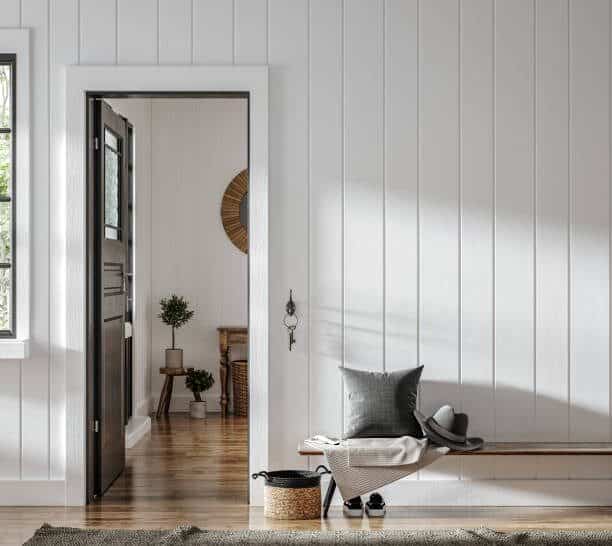Putting in a new door is such an easy way to completely change up any room in your house. But the idea of hanging a door yourself can seem kind of scary.
But with some good preparation and the right tools, it may end up being a really manageable DIY project that makes a huge difference. And the sense of accomplishment when that beautiful new door is hung? So rewarding.
So don’t let fear of imperfection stop you from trying it yourself. To help you get professional-looking results, here are ten tips we wish we had known before our first time installing a door.
Table of Contents
1. Gather the Right Tools Beforehand
The first thing you’ll want to have on hand is the right tools – it makes the installation process so much smoother.
From our experience, these are the must-haves:
- Tape measure – for precise sizing at every step
- Levels – 4-foot and 6-foot ones to keep everything plumb
- Pencil & utility knife – to mark cuts
- Drill & screwdriver – to attach hardware
- Quick door hanger brackets – these are game changers! Way easier than fiddling with shims
Oh, and don’t forget key safety gear – gloves, goggles, a step stool. Protecting yourself is priority number one.
Now, when buying tools, do yourself a favor and skip the generic hardware store varieties. Check out specialty shops like Men of All Trades Tool Line instead. Their products are made specifically for carpentry and will hold up much better than generic stuff.
Investing a few extra bucks in quality specialty tools really pays off by making projects like hanging a door go way smoother.
2. Choose the Right Door for the Space
The door you pick is a really important decision that will impact the whole look and feel of your space. Consulting a professional home door installer can help ensure that the door not only complements your style but is also set up to last. They have the expertise to provide recommendations based on your needs and to execute a flawless installation, preserving the aesthetics of your living space.
Here are some key things to consider when selecting a door:
- Where will it go – inside or outside? That determines whether you need an exterior or interior door.
- What room will it be in? A bedroom, bathroom, closet, or high-traffic area? That influences options like material, durability, and insulation.
- Precise size is crucial. Carefully measure the existing opening and get a door made to fit it just right.
- Material matters. Fiberglass or steel is best for exterior doors, while wood, MDF, or vinyl works for indoor ones.
- Style makes a statement. Panel doors, French doors, pocket doors – get creative with the design!
- For exterior doors, focus on weather resistance, energy efficiency features like insulation, and security elements like smart locks.
- For interior doors, look for options like pocket doors or soundproof doors if noise is a concern.
Taking the time to choose the perfect door for the specific space will ensure you end up with the right size, design, and features – basically, a door you’ll love coming home to every day.
It’s worth the effort to pick just the right one!
3. Check the Rough Opening Size
Before you buy a door, it’s really important to examine the existing rough opening super carefully. We can’t stress this enough – precise measurements here are key!
You’ll want to measure the width at both the very top and very bottom of the opening. Also, measure the height on both sides. Double-check it a couple of times just to be sure.
For the door to fit right, here are the clearance guidelines to follow:
- The rough opening should be 1/2 inch wider than the door width
- It should be 1/4 inch taller than the door height
That extra wiggle room is crucial to get the door into place and make any adjustments needed during installation.
If you find the rough opening is too narrow or short, you’ll need to make it larger. That involves cutting back more of the drywall or framing around the edges.
Taking the time to get extremely precise measurements of the rough opening will ensure your new door fits like a glove right from the start. Don’t skip this vital step!
4. Use Door Hanger Brackets
Installing the door itself used to involve lots of fiddly shimming to get it just right in the opening. But we recently discovered these genius quick door hanger brackets that make it so much easier!
These sturdy metal brackets completely replace shims. Here’s how to use them:
- Put a bracket right behind each hinge location
- Position 3 brackets along the latch side – top, middle, bottom
- They immediately stabilize the door and keep it from shifting out of whack
Door hanger brackets are game-changing for DIY installation. Unlike shims which need continual adjustment, the brackets provide immediate door straightening and support.
5. Draw Plumb Lines on the Hinge Side
To ensure the door hangs straight, use a 6-foot level to draw vertical plumb lines on the hinge side of the rough opening. Place the lines 1⁄2 inch in from the stud face framing the opening.
If you don’t have a 6-foot level, a 4-foot level will also work. Just be sure to stagger it from top to bottom to create a continuous line.
6. Fasten Top Hinge Bracket First
With plumb lines drawn, you’re ready to secure the door in place. Start by aligning the notch on the top hinge side bracket with the plumb line. Screw it tightly into the stud.
Setting this top bracket first gives you a fixed point to line up the rest of the installation.
7. Keep Door Level with Lower Hinge Brackets
After fastening the top bracket on the plumb line, install the remaining two hinge-side brackets, aligning the notches with the line.
Check for level front-to-back on the door’s bottom edge as you work downward. Adjust if needed to keep the door perfectly level.
8. Mind the Spacing on the Latch Side
With all hinge brackets securely in place, shift focus to properly spacing and fastening the three latch-side brackets.
First, check the reveal (the gap between the door edge and jamb) at the top of the door. Then, install the top latch-side bracket, matching that spacing.
For the middle and bottom latch-side brackets, match that same reveal spacing for consistency. The slots on the brackets allow minor adjustments as needed.
9. Consider Longer Screws for Heavy Doors
For lightweight hollow core doors, the included screw length is fine. But solid wood or steel doors require extra support to prevent sagging.
For heavy doors, remove the center hinge screw and replace it with a 3-inch screw that runs through the entire door frame and deep into the stud behind. This provides tremendous strength and stability.
10. Check Floor Clearances
Before tightening everything down fully, check floor clearances. Interior doors should have even spacing from floor to bottom jamb. If the flooring is already installed, you may need to trim the bottom of the jamb for proper clearance.
For exterior doors being installed before the flooring goes in, place shims under the jamb to account for the future flooring thickness.
Once proper clearances are achieved, securely tighten down ALL hardware.
Conclusion
With good planning, patience, and the right tools, installing a door on your own is an achievable DIY project. Door hanger brackets eliminate the frustrations of shimming and provide professional-level results.
Focus on precise measurements, plumb lines, proper spacing, floor clearances, and fully tightened hardware. Follow these tips, and you’ll have a stunning new door that will enhance your home in no time.





